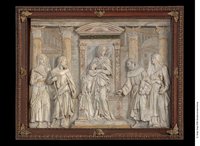After Andrea Guardi
ca. 1405-1476
Virgin and Child
Painted stucco
83 x 52 cm
Berlin, Staatliche Museen, Skulpturensammlung, Inv. SKS 2012.
Bode-Museum, storage.
Inscriptions: AVE GRASIA PLENA DOMINUS TECUM (“Hail Mary, full of grace. The Lord is with thee”, lower frame); ALPHA ET OMEGA (“Alpha et Omega” on the book held by the Christ Child, on the pediment).
Provenance
Florence (1893); Berlin, Skulpturensammlung/Altes Museum (1893-1904); Berlin, Skulpturensammlung/Kaiser-Friedrich-Museum (1904-1939); Berlin, storage (1939-1945); Soviet Union, secret storage (1945/46-1958); East Berlin, Skulpturensammlung/Bode-Museum (1958-1990); Berlin, Skulpturensammlung/Bode-Museum (1990-present).
Acquisition
Anonymous gift, 1893.
Restoration
1984.
Other Version
• Paris, Musée du Louvre, Inv. M.R. 2770. Painted marble, 53.5 x 42.8 x 10.5 cm.
Comment
The Virgin is praying over the lying, naked body of her son Jesus, whose head and upper back rest on a cushion and who blesses the beholder with his right hand. The composition, enhanced in vivid colors, is inscribed in a niche with antique pilasters. Christ the Judge, blessing with one hand and holding the Bible in the other, is painted on the pediment. The entablature of the tabernacle is lost, and the condition of the relief is problematic: while old photographs document the relief with a bronze patina, additions were made during a restoration in 1987 (especially to the left side of the Virgin’s hands) and much of the relief was repainted. The restoration is especially significant in the history of conservation in East Berlin. While many works that came back from the USSR in 1958 had just been restored with losses left visible as signs of the destruction wrought by “Hitler-fascism”, the praxis of restoration at the end of the Cold War was made in order for the public to enjoy the aesthetic qualities of the works, rather than see them as a document of the latest conflict.
The relief had been acquired in 1893 by the Berlin Museums as a replica of a work by Bernardo Rossellino. Schubring 1907a and 1907b linked the composition with a similar marble relief in the Musée du Louvre, which he ascribed to a minor follower of Donatello, Andrea Guardi. While this attribution is beyond doubt today (see Guardi’s Virtues in the Museo Nazionale di San Matteo, Pisa), it was at first difficult to accept for the Berlin Museums. In the Berlin catalogues, Schottmüller 1913 and 1933 preferred to insist on the links with Donatello: the position of the Virgin with her joined hands, the recumbent Child and the draperies are especially reminiscent of a Holy Family preserved in Berlin (see Inv. SKS 2387).
Literature
Schubring 1907a
Paul Schubring, “Andrea Guardi”, in Ulrich Thieme and Felix Becker (eds.), Allgemeines Lexilon der Bildenden Künstler von der Antike bis zur Gegenwart, Leipzig, Wilhelm Engelmann, 1907, I, p. 456: Andrea Guardi; disputes the attribution to the “style of Antonio Rossellino” made by the Kaiser-Friedrich-Museum.
Schubring 1907b
Paul Schubring, “Gli acquisti del museo ‘Kaiser Friedrich’”, L’Arte, X, 1907, p. 451: relates the work with the marble relief in the Musée du Louvre, and gives both to Andrea Guardi.
Schottmüller 1913
Frida Schottmüller, Die italienischen und spanischen Bildwerke der Renaissance und des Barocks in Marmor, Ton, Holz und Stuck, Berlin, Georg Reimer, 1913, p. 27 cat. 58: Florence, ca. 1450; free copy of a relief in the Musée du Louvre, attributed by Schubring to Andrea Guardi; the composition derives from a Holy Family by Donatello in the Berlin Museums (Inv. SKS 2387).
Schottmüller 1933
Frida Schottmüller, Die italienischen und spanischen Bildwerke der Renaissance und des Barock. Erster Band. Die Bildwerke in Stein, Holz, Ton und Wachs, Zweite Auflage, Berlin and Leipzig, Walter de Gruyter & Co., 1933, p. 16: follower of Donatello; the ancient polychromy is very
de

